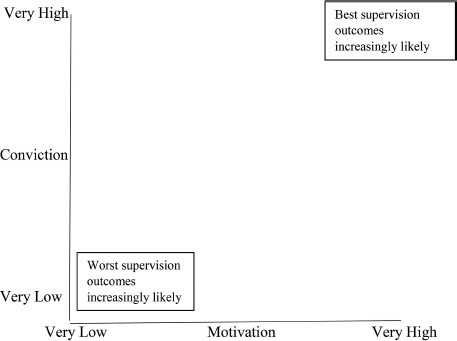Supervisor Allegiance Definition and Significance
Supervisor allegiance can most simply be defined as
belief in supervision effectiveness. Ideally, the supervisor has
conviction that supervision works (that it substantively contributes to therapist growth and has positive client impact) and accordingly provides conviction-consistent, growth-inducing supervision experiences. But any theoretical discussion about supervisor allegiance is missing, as is any empirical study about its supervisory impact (e.g.,
Bernard & Goodyear, 2014;
Hess, Hess, & Hess, 2008;
Watkins & Milne, 2014; based on Google Scholar search using the words “allegiance”, “supervision”, and “supervisor”).
We contend that, just as “patients want to know that their therapist believes in the treatment being provided” (
Wampold & Imel, 2015, p. 275), supervisees want to know that their supervisor believes in the supervision being delivered. In the CSRM (
Watkins, 2016; Watkins, Budge et al., 2015), supervisor allegiance is a
pivotal common factor, creating supervisee expectations for change, increasing the likelihood of both effective supervision being delivered and a positive supervision outcome occurring. We propose that
supervisor allegiance involves at least two inextricably intertwined components: (a) the degree to which the supervisor believes in and has conviction about the particular supervision being provided, and (b) the supervisor’s motivation to practice supervision. The supervisor is allegiant to the implemented form of supervision
and to the enterprise of supervision as an educational practice. Both conviction and motivation have been implicated in therapist allegiance (
McLeod, 2009), and we see it as being no different for supervision.
Quality and fidelity appear most affected by supervisor allegiance. According to our model’s prediction, supervisors rating high on both allegiance dimensions would (a) have the best supervision outcomes (positively impacting outcome goals;
Figure 1) and (b) show greater practice fidelity (e.g., in manual-driven supervision research;
Milne, 2010,
2014). Conversely, supervisors low on both dimensions would have the worst supervision outcomes and poorest practice fidelity.
Figure 2 provides a graphic depiction of the possible supervisor allegiance/supervision outcome relationships. Where the dimensions meet in the middle, mediocre, mixed results would be expected. Low/high variations can exist for myriad reasons, some examples follow: A new supervisor is struggling to define herself theoretically and is quite dissatisfied with her supervision approach (low conviction), yet is very committed to learning supervision and being an effective supervision practitioner (high motivation); or a seasoned supervisor is highly satisfied with his supervisory approach (high conviction), but is tired of doing supervision, needs a break, and feels burned out (low motivation). If supervisor allegiance is to be most specifically considered conceptually and empirically, we contend that
factoring both proposed dimensions into supervision study is absolutely essential.
Measuring Supervisor Allegiance
Wampold and Imel (2015) state that therapist allegiance, though difficult to study, must always be given attention. We believe that same statement could be said about supervisor allegiance, but no allegiance measure exists to drive supervision research. Developing an adequate supervisor allegiance scale or means of measurement (e.g., self-report, observational ratings) is a
prerequisite, what we see as preeminent priority. Altering existing therapist allegiance measures to fit the supervisory role could work (e.g., making the self-report/external ratings therapy allegiance measure of
Luborsky et al. [1999] supervision ready), provided appropriate therapy to supervision scale validation steps are taken (
Ellis, D’Iuso, & Ladany, 2008;
Ellis & Ladany, 1997). The formidable challenge of measurement must be aggressively confronted if supervisor allegiance study is to profitably proceed.



